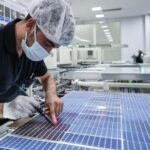Are you bored of relying on conventional assets of energy that harm the surroundings? Solar energy might also just be the answer you’ve been looking for. With its numerous benefits for the power grid, it is no wonder why increasingly more human beings are turning to this renewable energy source.
The power grid is facing challenging situations in meeting the increasing demand for power while additionally reducing emissions and environmental impact.
Solar power grid provides a sustainable solution that can assist in alleviating those challenges and creating a more resilient and green energy grid device.
This blog will cover the benefits that solar power brings to the power grid. Solar power is dramatically changing the way we generate and use power, increasing system resilience and reducing carbon footprint.
However, if you want to install a solar power system in your home, you must choose good options like Advanced Solar Solutions.
Let’s Explore What is Solar Energy
PV cells, a product of semiconductor materials like silicon, immediately convert daylight into energy via the photovoltaic effect. On the other hand, solar thermal systems use mirrors or lenses to pay attention to solar light in a small region, generating heat that may be used to produce energy via steam mills or different strategies.
Benefits of Solar Panel
1. Clean and Renewable
One of the most extensive advantages of solar energy is its cleanliness and renewability. Unlike fossil fuels, inclusive of coal, oil, and natural gas, the solar energy era produces minimal greenhouse gasoline emissions and no longer contributes to air or water pollutants.
By harnessing solar’s inexhaustible power, we can notably lessen our dependence on finite and environmentally dangerous assets, mitigating the impacts of climate change and can use it as a solar grid for home.
2. Abundant and Accessible
The solar energy grid is a plentiful supply of energy, providing the planet with more energy in an hour than the whole world uses in a year. Moreover, solar energy is widely accessible, with the ability to be used in nearly every corner of the globe.
This accessibility democratizes power production, permitting groups and people to generate their own energy and decrease reliance on centralized power systems.
3. Scalability and Modularity
Solar energy systems are enormously scalable and modular, making them suitable for a huge variety of packages, from residential rooftops to solar farms. This flexibility permits incremental expansion based on demand, taking into consideration the green deployment of solar assets to fulfill the needs of various markets.
Additionally, allotted solar installations can enhance grid resilience by means of decreasing the risk of considerable outages, as that’s how is solar energy used.
4. Cost-Effectiveness
Advances in solar technology and manufacturing strategies have caused vast value reductions in current years, making solar power increasingly popular with traditional energy sources.
The Levelized value of energy (LCOE) for solar photovoltaics has declined dramatically, making it one of the maximum cost-powerful options for brand-spanking new power technology ability in many areas.
Additionally, a long-term rate balance protects purchasers from the volatility of fossil gasoline markets and decreases power payments over the years when you choose a solar power grid.
5. Grid Integration and Ancillary Services
The benefits of solar panel may significantly contribute to improving the stability and dependability of the electrical grid. Grid-scale solar installations can make a contribution to voltage law, frequency management, and grid balancing, supporting machine balance and resilience in the face of fluctuations in supply and demand.
Moreover, the combination of solar power with power storage technologies, such as batteries, allows the supply of dispatchable power and grid offerings, in addition to enhancing the price proposition of solar power.
6. Job Creation and Economic Growth
The fast expansion of the solar energy grid has brought about the creation of millions of jobs globally, starting from production and installation to analyze and development. By making an investment in solar power infrastructure and a group of workers improvement, governments can stimulate financial growth, foster innovation, and construct a sustainable power future.
Additionally, localized solar projects can provide monetary possibilities in rural and underserved communities, riding inclusive development and lowering income inequality.
Advantages |
Homes |
Commercial & Residential |
Schools |
| 1. Cost Savings | Reduce power bills, long-term costs | Lower operating expenses, increase property value | Lower utility costs, allocate savings to education |
| 2. Energy Independence | Generate own power, reduce grid reliance | Enhance energy security, hedge against price volatility | Ensure uninterrupted power supply for education |
| 3. Environmental Impact Reduction | Minimize carbon footprint, mitigate climate change | Demonstrate corporate responsibility, sustainability | Educate on renewable energy, environmental stewardship |
| 4. Resilience and Reliability | Improve grid resilience, reduce vulnerability | Ensure business continuity, maintain operations | Provide a stable power supply for educational needs |
| 5. Educational Opportunities | Teach about renewable energy, sustainability | Engage in energy conservation efforts, awareness | Foster STEM education, hands-on learning |
| 6. Government Incentives | Access tax credits, incentives, rebates | Benefit from financial incentives, grants | Utilize funding opportunities for solar projects |
| 7. Long-term Investment | Increase property value, marketability | Enhance building reputation, attract tenants | Invest in sustainable infrastructure for benefits |
Wrap Up!
Solar energy holds huge promise as a smooth, ample, and sustainable source of energy for the 21st century. By harnessing the energy of the solar, we are able to lessen our reliance on fossil fuels, mitigate the effects of climate trade, and build a greater resilient and equitable energy machine.
You can have it whether it’s a solar grid for home or any other place you like.
However, realizing solar power’s full capacity would require concerted efforts from governments, businesses, and communities to invest in studies, infrastructure, and coverage frameworks that support its extensive adoption.
With continued innovation and collaboration, solar energy can emerge as a cornerstone of the cutting-edge power grid, powering a brighter and more sustainable future for generations to come.






